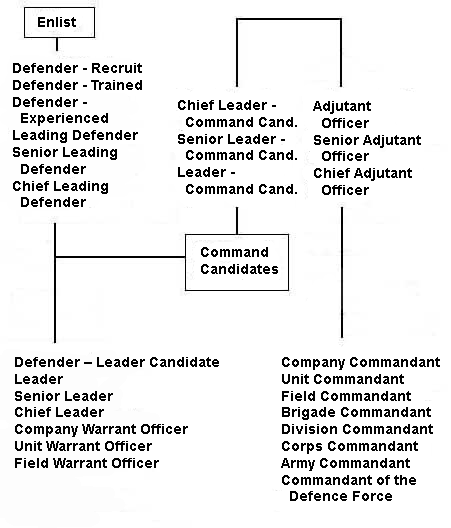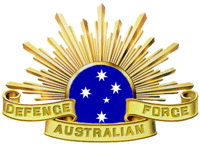AUSTRALIAN DEFENCE FORCE –
OVERVIEW
by A. Gubler
Introduction
The Australian Defence Force (ADF) is a complex military force with many differences to the established model of other national armies, navies and forces.
History
Organisation
Recruitment
Ranks
Role Playing
The ADF was formed in the early 1980s
to combine and rationalise command and support functions for the then
Royal Australian Navy, Australian Army and Royal Australian Air Force.
During the next decade the ADF expanded into training and operational
command. But it wasn’t until after the devastation of the Twilight
War (1995-2000) that the ADF took primacy over the separate armed
services to create a combined military force. The Twilight War
effectively reduced the Navy and Air Force into maritime and air arms,
respectively, of the Army. By the end of Australian military rule in
2020 the ADF had effectively become a single service. But it wasn’t
until 2088 until the Navy, Army and Air Force were officially disbanded
and reconstituted as force commands of the ADF. For most of the 21st
century the ADF played a major role in governing
|
The Evolution of the ADF’s Rising
Sun Badge
Proudly
worn by Australian soldiers for four centuries the “Rising Sun”
badge has become an integral part of “Digger” tradition. The distinctive
shape, worn on the upturned brim of a slouch hat, is readily identified
with the spirit of ANZAC. Yet despite the badge’s historic significance
there remains confusion as to how it was adopted. In 1902 a badge
was urgently sought for the Australian contingents raised for
service in
2088 |
The ADF is divided into 12 force commands
with peculiar responsibilities. There are four combat force commands;
Naval Command (NAV COM) for maritime operations, Field Command (FD COM)
is the ground army, Air Force Command (AF COM) – the ADF’s air force,
and Space Force Command (SF COM) which operates space installations
and ships, including Australia’s stutter-warp capable military vessels.
The four “command” force commands are High Command (HI COM), the Headquarters
of the ADF, Intelligence Command (INTEL COM) for gathering and understanding
military information, Communications Command (COMS COM) that links the
ADF and provides a war-time back up to the civilian national communications
infrastructure and Inspection Command (SPEC COM) the ADF’s training
and standards force. The four support force commands are Medical Command
(MED COM), Administration Command (ADMIN COM), Technical Command (TECH
COM) and Logistics Command (LOG COM). The ADF
has five regional theatres and special mission forces. Earth Theatre
(ET) is responsible for military operations on Earth, within its orbit
and up to the outer extent of the Solar system. Tirane Theatre (TT)
has similar responsibilities on
Recruitment into the ADF is voluntary
in full-time, part-time or militia enlistments. The total ADF personnel
strength is 940,000 regulars (550,000 full-time and 390,000 part-time)
and 285,000 militia. All Australian citizens are required to complete
a period of low-pay government service unless they are exempted and
some choose to do this service with the ADF. Exemptions are only available
for extreme medical or psychological reasons or if a citizen is living
in an underdeveloped territory such as the colonies and far station
outposts. This service is to be equal to 36 months full-time employment
from the age of 24 and before reaching the age of 30 and an additional
18 months after that time to be completed by the age of 60. There are
many different types of mandatory government service filling roles in
every government department and bureau, approximately 850,000 young
Australians start their service each year, of this number about 50,000
are successful in applying to serve with the ADF. Most of these personnel
serve two years full time followed by part-time service for the next
four years, they then usually go on to fill the ranks of the ADF’s militia
serving about two weeks a year. Even though
the ADF uses a form of voluntary national service the main bulk of its
personnel are long service professionals, serving a minimum enlistment
of eight years which is then renewed biannually until retirement or
transfer to part-time or militia service. Part-time service is unlike
the historical notions of “reserve” service (even though part-time formations
and units carry this title). In the core-worlds of the 24th Century
(Earth and
The ADF has evolved away from the
anachronistic system of dividing soldiers up into “enlisted” and “commissioned”
personnel to a more modern and effective system. All personnel enlist
in the ADF as Defenders however those with leadership and command potential
are recognised early on and become candidates for high rank. This system
is flexible; receiving a candidate rank is no guarantee of eventual
promotion if a Defender doesn’t fulfil adequately their field responsibilities
and special training. The large number of Defender grades also allows
the ADF to recognize long service by those who may not have formal leadership
potential but who play a valuable role in the service. Leaders are perhaps the most important rank level in the ADF. They command
the basic field units from Sections/Patrols to Platoons/Troops and provide
instrumental leadership to the components operations of other commands.
The Leader grade is also where a future Commandant learns their trade
as a field leader. Leaders are the equivalent to Corporals, Sergeants
and Lieutenants in more traditional rank structures. The Warrant Officer grade is perhaps
the least changed in the history of the ADF. WOs are responsible for
maintaining discipline and standards amongst Leaders and Defenders.
They also provide a stock of field experience and wisdom for Commandants
to rely upon in the field. The Adjutant Officer grade provides the ADF with its staff officers and
administrators. AO grades are very flexible and filled with potential
Commandants fresh from

|
Rank |
Code |
Typical
Position |
Insignia |
|
Defender – Recruit |
D1 |
Recruit
undergoing basic and specialist training |
|
|
Defender – Trained |
D2 |
Fully
trained soldier posted to a unit |
|
|
Defender – Experienced |
D3 |
Experienced
defender with at least two years or operational service |
|
|
Defender – Leader Candidate |
D3LC |
Candidate
for leader rank |
|
|
Defender – Command Candidate |
D3CC |
Candidate
for commandant rank |
|
|
Leading Defender |
D4 |
Experienced
and highly trained defender with at least four years service |
|
|
Senior Leading Defender |
D5 |
Experienced
and highly trained defender with at least eight years service |
|
|
Chief Leading Defender |
D6 |
Experienced
and highly trained defender with at least 16 years service |
|
|
Leader |
L1 |
Commander
of a section |
|
|
Leader – Command Candidate |
L1CC |
Candidate
for commandant rank training at a defence force academy |
|
|
Senior Leader |
L2 |
Deputy
platoon commander |
|
|
Senior Leader – Command Candidate |
L2CC |
Candidate
for commandant rank during a field placement as a deputy platoon
commander |
|
|
Chief Leader |
L3 |
Commander
of a platoon |
|
|
Chief Leader – Command Candidate |
L3CC |
Candidate
for commandant rank during a field placement as a platoon commander |
|
|
(Sub-Unit) Warrant Officer |
WO1 |
Senior
NCO to a small ship or sub-unit |
|
|
(Unit) Warrant Officer |
WO2 |
Senior
NCO to a medium ship or unit |
|
|
(Force Command) Warrant Officer |
WO3 |
Senior
NCO to a large ship, formation, or base |
|
|
Adjutant Officer |
AO1 |
Junior
staff officer |
|
|
Senior Adjutant Officer |
AO2 |
Mid
level staff officer |
|
|
Chief Adjutant Officer |
AO3 |
Senior
staff officer |
|
|
(Sub-Unit) Commandant |
C1 |
Commander
of a small ship or sub-unit |
|
|
(Unit) Commandant |
C2 |
Commander
of a medium ship or unit |
|
|
(Force Command) Commandant |
C3 |
Commander
of a large ship, task force or base |
|
|
(One Star) Commandant |
C4 |
Commander
of a formation |
|
|
(Two Star) Commandant |
C5 |
Commander
of a division |
|
|
(Three Star) Commandant |
C6 |
Commander
of a fleet, corps, group or force |
|
|
(Four Star) Commandant |
C7 |
Commander
of a force command or theatre |
|
|
Commandant of the Australian Defence Force |
C8 |
Commander
of the ADF |
|
Force
Command Respective Rank Titles
The rank titles of Warrant Officers
and Commandants are dependent on their level of command and their unit
and/or force command. (Sub-Unit) WOs and Commandants carry the name
of their type of sub-unit, most likely Company, Corvette or Deck. (Unit)
WOs and Commandants likewise have the name of their type of unit, there
are a large number of variations in this category but Unit itself is
most common plus Squadron, Battalion, Ship, Cruiser and
|
Command Level |
NAV COM |
FD COM |
AF COM |
SF COM |
Other Commands |
|
One Star |
Flotilla |
Brigade |
Wing |
Flotilla |
Formation |
|
Two Star |
Division |
Division |
Division |
Division |
Division |
|
Three Star |
Fleet |
Corps |
Group |
Fleet |
Force |
|
Four Star |
Navy |
Army |
Air Force |
Space Force |
Defence |
To join the ADF the character must be
an Australian with strength, dextirity, endurance, intelligence and
education of at least 10. Enlistment to the ADF is only after having
spent at least six years in other careers however ADF service does not
require a “turning point” nor count as part of the two career limit.
Conscripts who choose not to serve longer than the minimum required
automatically receive a three year career unless changing to a Extralegel
Career in which the time in career can be less. Career skills are as
in the Adventurer’s Guide except:
Field Command Military Career
Initial Training: Combat Rifleman: 4, Heavy Weapons: 2, Melee: 2, Hover Vehicle: 1, Survival: 1, Tactics: 1 and First Aid-1 (Ground Vehicle: 1, Swim: 1 if not chosen as Background Skills)Primary Skills: All Combat Skills, Ground Vehicle, Hover Vehicle, Stealth, Engineering and all General SkillsRelated Skills: Aircraft Pilot, Beareacracy, Computer, Streetwise



































